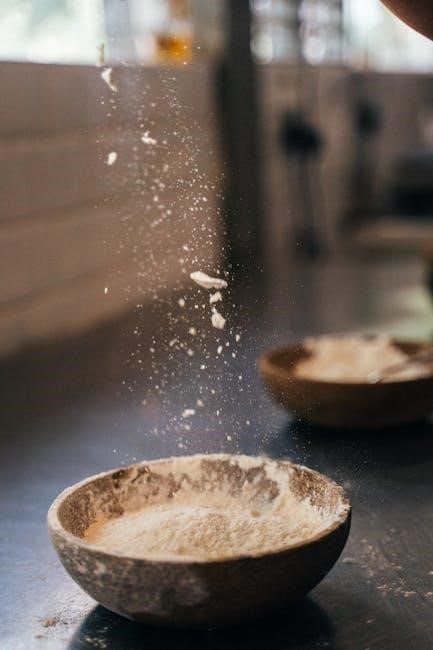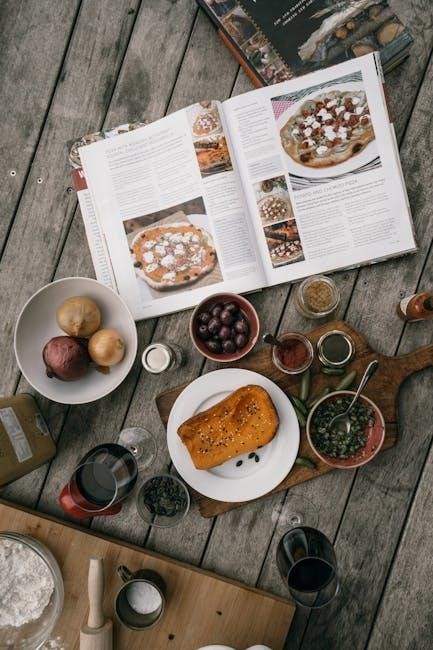Farina, a versatile breakfast cereal, offers a quick and wholesome start to your day. Its mild flavor and smooth texture make it a popular choice for easy customization with various add-ins like fruits, nuts, and spices, accommodating both sweet and savory preferences. This traditional dish, also known as cream of wheat, is a simple yet nutritious option for all ages, providing sustained energy and a comforting meal. Whether enjoyed plain or enriched with flavorful ingredients, farina’s adaptability ensures it remains a beloved morning staple worldwide.
1.1 What is Farina?
Farina is a finely milled wheat product, often referred to as cream of wheat, used to make a soft, creamy porridge. It is a popular breakfast cereal known for its mild flavor and quick cooking time. Farina can also be incorporated into baked goods, adding texture and nutrition. Its versatility allows it to be enjoyed in both sweet and savory dishes, making it a staple in many global cuisines.
1.2 Popularity of Farina as a Breakfast Option
Farina is a beloved breakfast cereal due to its simplicity and versatility. Its mild flavor and quick preparation make it a favorite for busy mornings. Globally, farina is cherished for its comforting texture and ability to be customized with sweet or savory ingredients. It is particularly popular in Latin American and Caribbean cuisines, where it is often enjoyed as a nostalgic and wholesome start to the day.

Basic Cooking Process
Farina is prepared by heating liquid, gradually whisking in the cereal, and stirring continuously. It simmers until thickened, achieving a smooth, creamy texture in minutes.
2.1 Overview of the Cooking Method
Cooking farina involves boiling milk or water, then gradually whisking in the cereal. Stir continuously to prevent lumps, reduce heat, and simmer until thickened, usually 5-10 minutes. Optional additions like salt, vanilla, or sweeteners can enhance flavor. The process ensures a smooth, creamy texture, making farina a simple yet satisfying breakfast option.
2.2 Essential Steps for Preparing Farina
Begin by bringing milk or water to a near boil in a saucepan. Gradually whisk in farina to prevent lumps, stirring continuously. Reduce heat to low, cover, and simmer for 5-10 minutes until creamy. Optionally, add salt, vanilla, or sweeteners. Stir occasionally to avoid sticking. Remove from heat when desired consistency is reached, serving warm for a smooth, comforting breakfast.
Choosing the Right Liquid
Choosing the right liquid for farina affects its texture and flavor. Options include milk, water, broth, or plant-based alternatives, each offering unique benefits and catering to different tastes and dietary preferences.
3.1 Milk vs. Water: Which is Better?
Milk and water offer distinct advantages for farina. Milk adds richness, creaminess, and extra nutrients like calcium and protein, enhancing flavor. Water is lighter and ideal for those preferring a dairy-free option. Both liquids work well, but milk is preferred for a heartier, more indulgent texture, while water suits simpler, lighter versions of farina.
3.2 Adding Flavor with Broth or Plant-Based Milks
Enhance your farina by using broth or plant-based milks for added flavor and nutrition. Broth infuses a savory twist, perfect for a hearty breakfast, while plant-based milks like almond or oat offer creaminess without dairy. These options cater to diverse dietary preferences and elevate the dish with unique flavors, making farina versatile for both sweet and savory enthusiasts alike.
Tools and Equipment Needed
A medium saucepan, preferably non-stick, is ideal for cooking farina. Use a whisk or fork for smooth stirring and a lid to cover the pot during cooking.
4.1 Pots and Stovetop Requirements
A medium-sized, non-stick pot is ideal for cooking farina to prevent sticking and ensure smooth stirring. A stovetop with adjustable heat is essential for maintaining the right temperature, allowing the farina to simmer gently without burning. Use a pot with a heavy bottom or a heat-diffusing stovetop to distribute heat evenly, ensuring a consistent cooking process for the perfect texture.
4.2 Importance of a Whisk or Fork for Stirring
A whisk or fork is crucial for stirring farina to achieve a smooth consistency. Stirring constantly prevents lumps from forming as the farina cooks. A fork can break up clumps effectively, while a whisk ensures even distribution of heat and ingredients. Proper stirring tools are essential for creating a creamy, lump-free texture that enhances the overall enjoyment of the dish.

Ratio Guidelines
The ideal liquid-to-farina ratio is typically 4:1, ensuring a smooth, creamy texture. Adjusting this ratio allows for thicker or thinner consistency, catering to personal preference and recipe needs.
5.1 Liquid to Farina Ratio for Perfect Consistency
The ideal ratio for farina is 4 cups of liquid (milk or water) to 1 cup of farina. This ensures a smooth, creamy texture without lumps. Using milk adds richness, while water keeps it light. Adjust the ratio to achieve your desired consistency—thicker for a hearty porridge or thinner for a more pourable texture. This balance is crucial for a perfect, even cook.
5.2 Adjusting the Ratio for Thicker or Thinner Farina
To achieve a thicker consistency, use slightly less liquid, starting with a 3:1 ratio. For a thinner texture, gradually add more liquid beyond the standard 4:1 ratio. Adjustments can be made during cooking by adding small amounts of liquid or farina, stirring continually to maintain smoothness. Personal preference guides these tweaks, ensuring the perfect balance between hearty and pourable.
Add-Ins and Flavorings
Add sugar, vanilla, or spices for sweetness, while nuts, seeds, and fruits enhance nutritional value and texture. These additions allow customization to suit any taste preference.
6.1 Sweet Additions: Sugar, Vanilla, and Spices
Sweetening farina with sugar, vanilla extract, or cinnamon enhances its flavor. Vanilla adds a creamy aroma, while cinnamon provides warmth. These simple additions transform farina into a dessert-like treat, perfect for a cozy breakfast or snack. Experimenting with different spices offers variety, ensuring each bowl is uniquely delicious and tailored to your taste preferences.
6.2 Nutritional Enhancements: Nuts, Seeds, and Fruits
Enhance farina’s nutrition by adding nuts, seeds, and fruits. Chia seeds and flaxseeds boost omega-3 content, while almonds and walnuts add healthy fats. Dried or fresh fruits like raisins, berries, or bananas introduce natural sweetness and fiber. These additions not only diversify the flavor but also make farina a more balanced and satisfying meal, perfect for health-conscious individuals seeking extra nutritional benefits.

Step-by-Step Instructions
Start by heating your chosen liquid in a saucepan. Gradually whisk in farina, ensuring smoothness. Cook on low heat, stirring frequently, until the mixture thickens to your liking, achieving the perfect texture for a delicious breakfast.
7.1 Heating the Liquid and Mixing Farina
Begin by heating your chosen liquid (milk or water) in a saucepan over medium heat until it nearly boils. Gradually whisk in the farina, stirring constantly to prevent lumps. Reduce the heat to low and continue stirring until the mixture smooths and thickens slightly. This step ensures even cooking and a creamy texture, forming the base for a perfect farina dish. Add sugar, vanilla, or spices if desired for extra flavor.
7.2 Cooking Time and Desired Texture
Cook farina for 5-10 minutes, stirring occasionally, until it reaches your preferred consistency. It starts runny and thickens as it cooks. For a creamier texture, cook it longer; for a thinner consistency, add a little more liquid. Monitor closely to avoid burning and remove from heat when it’s smooth and tender, ensuring a perfectly cooked breakfast cereal every time you prepare it properly.

Tips for Avoiding Lumps
Use a whisk or fork to stir constantly when adding farina to hot liquid. Heat the liquid first, then gradually whisk in farina to prevent clumps.
8.1 Stirring Techniques to Ensure Smoothness
Continuous stirring is key to preventing lumps. Use a whisk or fork to blend farina into the liquid smoothly. Stir in one direction, ensuring even distribution. Avoid adding farina too quickly, as this can cause clumps. Maintain steady heat and whisk vigorously to achieve a creamy texture. This method ensures a lump-free, velvety consistency every time.
8.2 Fixing Lumps During the Cooking Process
If lumps form, immediately remove the pot from heat to prevent further cooking. Use a whisk or fork to gently break down the clumps, stirring thoroughly. For stubborn lumps, a fine-mesh strainer can be used to remove them. Return the mixture to low heat, whisking continuously until smooth. This method restores the farina to a creamy texture without overcooking.
Advanced Farina Recipes
Explore creative ways to elevate farina beyond breakfast. Incorporate it into baked goods, savory dishes, or desserts for a unique twist, enhancing both flavor and texture effortlessly.
9.1 Incorporating Farina into Baked Goods
Farina adds a delightful texture and nutty flavor to baked goods. Use it in bread recipes for a denser loaf or blend with flour for pastries and cookies. Substitute up to 25% of flour with farina for enhanced nutrition and a unique taste. It pairs well with spices like cinnamon and nutmeg, making it ideal for sweet treats like muffins or cakes. This versatile grain elevates baked goods effortlessly while maintaining simplicity.
9.2 Savory Farina Dishes for Breakfast or Dinner
Farina can be transformed into a hearty savory dish by adding vegetables, herbs, and spices. Try incorporating sautéed onions, garlic, and tomatoes for a flavorful base. For a breakfast twist, mix in eggs or cheese, while for dinner, add cooked meats or broth for a comforting meal. This versatile grain adapts well to both morning and evening recipes, offering a satisfying alternative to traditional porridge.

Common Mistakes and Solutions
Common mistakes include overcooking, undercooking, or letting farina burn. Solutions: Adjust heat, stir constantly, and monitor liquid absorption for a smooth, creamy texture without stickiness or lumps.
10.1 Overcooking and Undercooking Farina
Overcooking farina leads to a thick, unappetizing texture, while undercooking results in a gritty, unfinished feel. To avoid these, monitor the cooking time closely and adjust heat as needed. Ideal farina should be smooth and creamy, with a consistency that’s neither too runny nor too dense. Proper stirring and attentive cooking ensure the perfect texture every time. Regular checks prevent overcooking and undercooking issues effectively.
10.2 Managing Stickiness and Burning
Stickiness and burning are common issues when cooking farina if not monitored properly. To prevent stickiness, ensure the liquid ratio is accurate and stir constantly, especially during the initial stages. Burning occurs when heat is too high or the pot is left unattended. Regular stirring and adjusting heat to a low simmer can help avoid these issues. Always scrape the bottom of the pot to prevent scorching and ensure even cooking. If burning occurs, remove from heat immediately and adjust the mixture to salvage the dish. Proper attention and stirring techniques are key to achieving a smooth, non-sticky texture without burning.
